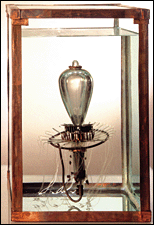 |
Metrowest
Daily News Garden
of Sticks and Stones by CHRIS BERGERON, NEWS STAFF WRITER |
LINCOLN -- If sculptor Joseph Wheelwright had carved the giant stone heads on Easter Island, instead of brooding, long-eared moai, explorers might have found rows of yawning, yodeling, yowling rock heads.
For his seventh exhibition at the DeCordova Museum and Sculpture Park, the Massachusetts native has transformed the Terrace Gallery into an enchanting garden of sticks and stones where inanimate objects tickle visitors' imaginations.
In combination with challenging works by mid-career artists in the "2003 DeCordova Annual Exhibition," the Lincoln museum has staged a "must see" summer show for anybody willing to set their mind free.
Works by three regional artists -- two photographers and a sculptor -- positively bend, and perhaps, break the boundaries of convention, creating their own private realms of personal creativity.
- Steve Hollinger assembles light-activated mechanical sculptures that defy categorization, existing as an amalgam of science and art.
- Hannah Barrett's "family portraits" take gender-bending to dizzying, even disturbing, extremes.
- Laura
McPhee's ultra-realistic photography discovers haunting beauty in the deterioration
of man-made objects.
Featuring 11 artists from six New England states, the annual exhibition runs through Aug. 31.
[review:
Joe Wheelwright, "Stone menagerie"]
Boundary Busters
The
varied works of 11 "emerging, mid-career and established artists"
offers a generally pleasurable mixed bag of unexpected delights, leavened
by a few exhibits that are merely clever.
At their best, works like Dave Cole's giant fiberglass sculptures and Lars-Erik
Fisk's beach ball-shaped Volkswagen, are interesting and fun but leave no
lasting impression.
But, judging from their submissions, Hollinger, Barrett and McPhee have clearly
staked out private realms of creative expertise that deserve attention.
A Connecticut native now working in Boston, Hollinger fashions tiny sculptural
installations from "found objects" like a bat skeleton or dry leaves,
combining mechanical and organic energy in startling ways.
Encased in a wooden box, a delicate bat skeleton seemingly floats at the end
of tiny wires that, when activated, let the bones drift apart in a weird mimicry
of flight.
Hollinger has said he hopes his works provide a bridge between "our physical
world and the world of our emotions, joy, desire and despair."
By blurring the boundaries between art and science, they do more: they invite
us to ponder our own fragile mortality and the ineffable spirit that moves
us.
In another piece, Hollinger has made a model heart from glass, tubes and flowing
blue "blood" that both replicates and mocks the real thing with
its haunting delicacy.
In such works, he subverts the boundary between the organic and mechanical
worlds, challenging viewers to decide where life begins and ends.
The most visually striking piece, a large mechanical transparent jellyfish,
made from glass, tubes and wire, is a wonder of ingenuity and imagination
when it dangles its tentacles in an eerie submarine dance.
In an age when microchips are ubiquitous, Hollinger's sculptured installations
remind visitors of the mysterious connections between seemingly unrelated
worlds.
A native New Yorker now teaching at the Massachusetts College of Art, McPhee
photographed the interiors of decaying Indian mansions, theaters and shops
with a eye to recording buried layers of history and culture.
On one level, these images of Calcutta are striking merely for McPhee's ability
to capturing vivid colors that reveal beauty in deterioration.
Yet, as a byproduct, like a good archaeologist peeling back layers of sediment,
McPhee's images conjure India as a potpourri of local cultures coping with
centuries of colonization.
At once, they are gorgeous pictures of India that reveal a land of exotic
flavors, scents and beliefs as well as the "web of religion, politics
and history" that went into them.
The exhibit's most striking works, Barrett's photo montages are -- in equal
parts -- bizarre, disturbing and liberating.
Using her own parents, she combines parts of their physiognomy to create "anonymous
hybrids" that fuse gender and familial roles in frankly unsettling way.
What's male or female? Who's Mom? Who's Dad? Why's Dad have breasts? Why's
Mom in trousers?
Though the program notes suggest Barrett made her photo montages in an effort
to examine the dangers of genetic engineering, her images more than stand
on their own as an exploration of the blurring and merging of identity in
a standardized world.
Love them or hate them, visitors ignore works by Hollinger, Barrett, McPhee and, of course, Wheelwright at their own peril. Powerful and provocative yet fun, they are the highlights of two shows in a single venue that offers one-stop serendipity for anyone who loves art.
© Copyright 2003 Metrowest Daily News